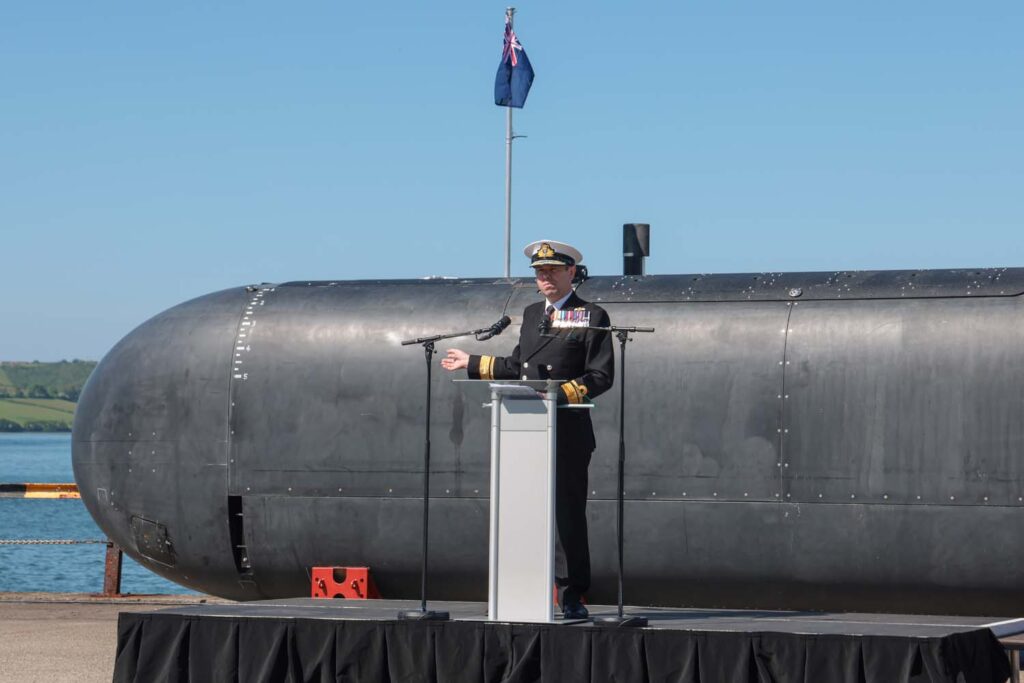In a groundbreaking display of modern naval innovation, the Royal Navy robotic sub XV Excalibur has offered a glimpse of the future of maritime defense. Recently, the prototype submarine patrolled the waters at HMNB Devonport in Plymouth, England, while being controlled from a command center located 10,000 miles away in Australia.
This achievement not only highlights the growing power of remote naval operations but also underscores the strategic value of robotics in shaping future military fleets. The Royal Navy has been at the forefront of maritime defense for centuries. With the introduction of XV Excalibur, the Navy is venturing into a new era where robotics and artificial intelligence (AI) play central roles.
Unlike conventional submarines that require large onboard crews, this robotic submarine is unmanned and remotely operated, reducing human risks in hostile waters. The ability to control a Royal Navy robotic sub from 10,000 miles away demonstrates not just technological advancement but also adaptability.
Long distance control opens doors for multinational collaborations, secure maritime patrols, and extended operations without the logistical challenges of traditional deployments.
The Technology Behind XV-Excalibur
The XV Excalibur is no ordinary submarine. It combines advanced sensors, AI assisted navigation, and encrypted communication channels to ensure smooth remote operation. Engineers designed it with modular capabilities, allowing future upgrades for surveillance, reconnaissance, and even combat roles.
According to naval technology experts, the submarine’s control system relies on a blend of satellite communications and secure military data networks. This ensures that commands from Australia to Plymouth can be transmitted with minimal latency. It also underscores the importance of cybersecurity in preventing hostile interference.
To better understand the significance of this achievement, let’s consider expert perspectives. Commander Richard Stannard Royal Navy Officer, Retired, The XV Excalibur marks a shift in naval warfare comparable to the arrival of nuclear powered submarines. Remote control from across the globe not only extends operational flexibility but also reduces risks to human life in volatile regions.
Dr. Amelia Clarke Maritime Defense Analyst, University of Portsmouth, This development is about more than technology. It’s about deterrence. When adversaries know that the Royal Navy can deploy and control robotic submarines from anywhere in the world, it changes the dynamics of naval strategy.
Lt. Sarah Mills Royal Navy Robotics Division, As someone directly involved in trials, I can say the transition wasn’t easy. Controlling a vessel in Plymouth from Australia demanded precision coordination and flawless communication links. But the success proves it’s possible.
Remote Naval Operations in Action
A relevant case study comes from the US Navy’s experiments with unmanned surface vessels USVs. In 2022, the US Navy conducted remote operations of its Sea Hunter vessel across the Pacific. Much like XV Excalibur, Sea Hunter proved that robotic assets could be deployed for months without onboard crew, performing surveillance and reconnaissance missions.
The Royal Navy’s success builds on these lessons but goes further controlling a robotic submarine from 10,000 miles away. This long distance coordination pushes the boundaries of what militaries believed possible and sets a new benchmark in naval technology.
For naval families, the introduction of the Royal Navy robotic sub represents peace of mind. Traditional submarine missions are notoriously dangerous, with crews spending weeks or months in confined, high risk environments. By replacing human crews with robotics, the Navy reduces the emotional burden on families who fear for their loved ones during deployments.
One spouse of a Royal Navy officer shared, Knowing that fewer lives are at risk because of unmanned subs like XV Excalibur is a relief. Technology is not just changing warfare it’s changing the way we live as military families. This human perspective emphasizes that innovation in defense is not just about firepower but also about humanity.
Strategic Implications
The Royal Navy’s leap into robotic submarines brings several longbterm implications. Human crews are spared from dangerous missions, especially in contested waters. Remote control across continents allows the Royal Navy to operate anywhere without physically deploying personnel.
Without the need for onboard living quarters, food, and life support systems, robotic submarines can be built and maintained at a fraction of the cost. By showcasing XV Excalibur, the UK signals to allies and rivals alike that it intends to remain a global naval power.
While XV Excalibur is a prototype, future iterations may carry advanced weapons, transforming naval engagements entirely.
The Ethical and Security Debate
While the technology is impressive, it raises ethical and security questions. Should robotic submarines be armed with lethal capabilities? How secure are they from cyberattacks? Could adversaries hijack or disable such systems?
Cybersecurity expert Dr. Michael Hayes warns. Robotic naval assets must be hardened against cyber threats. A hijacked submarine could pose catastrophic risks not only to the Navy but also to civilian shipping routes. This highlights the need for ongoing debate around how far militaries should push automation in warfare.
The XV Excalibur is a prototype, but experts predict that within the next decade, fleets of Royal Navy robotic subs will patrol international waters. They could conduct anti submarine warfare, mine detection, and undersea cable protection, all without risking human lives.
For the UK, this is also a strategic investment in sovereignty. In a world where adversaries are rapidly developing naval technologies, the Royal Navy’s innovation ensures that Britain maintains a technological edge.
The successful remote operation of the Royal Navy robotic sub XV-Excalibur from 10,000 miles away is more than a technical demonstration it’s a vision of the future. With reduced human risk, expanded global reach, and strategic deterrence, robotic submarines may soon become the backbone of modern naval fleets.
As with all transformative technologies, challenges remain ethical debates, cybersecurity threats, and international regulations must be addressed. Yet one thing is clear the XV Excalibur signals that the Royal Navy is not just keeping pace with the times, but leading them.

